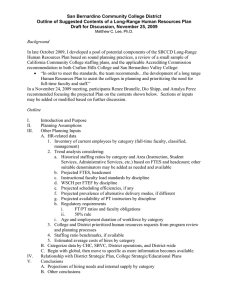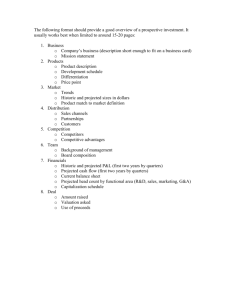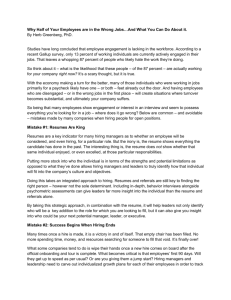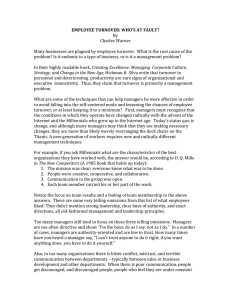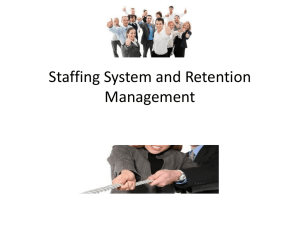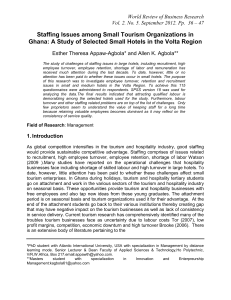Chapter 3: Human Resource Planning, Recruitment, and Selection
advertisement
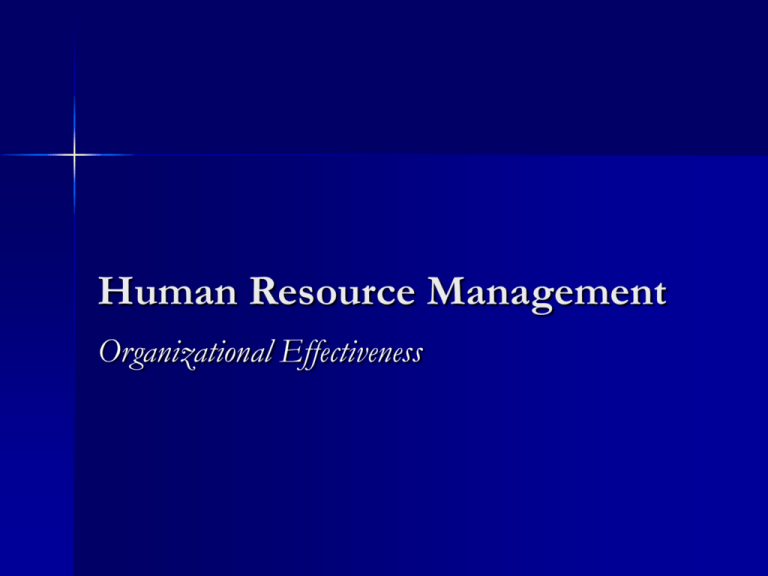
Human Resource Management Organizational Effectiveness Development of Human Resource Management Parallels the protection and treatment of workers Social Welfare Department 1. a. b. c. 4. 1880 – 1935 Helping injured workers and their families Company unions: parties and social events Worker health a. b. c. d. e. f. Labor Relations Department 2. a. b. 1935 – 1950 Collective bargaining Contract administration Industrial Relations Department 3. a. b. c. d. 1950 – 1970 Labor relations Benefits and vacations Testing and selection Compensation systems Personnel Department 5. 1970 – 1990 Legal compliance Staffing Performance evaluation Compensation and benefits Employee relations Safety and health Human Resource Management Staffing Model Human Resource Planning Recruitment Strategic Business Planning Human Resource Planning Long-range planning Strategic Planning Environmental Scanning Middle-range planning Operational Planning Forecasting Short-range planning Goals and Objectives Projected Staffing Requirements Recruitment Planning Applicant Search Selection Preliminary Screening Selection Decision Placement Forecasting Employment Needs 1. 2. 3. 4. 5. Budgeting Work-load Analysis Unit Demand Expert Opinion Trend Predictions Example of Predicting Labor Supply and Required New Hires for a Hotel Chain Supply Analysis Supply Demand Comparison A % Quit (rounded) (1996-1998) B Number of Present Employees C Projected Turnover by 2000 D Employees Left by 2000 E Projected Labor Demand in 2000 F Projected New Hires in 2000 General Manager 38 25 10 15 32 17 Resident Manager 77 9 7 2 12 10 Food/Beverage Director 47 23 11 12 29 17 Controller 85 25 21 4 32 28 Assistant Controller 66 14 9 5 18 13 Chief Engineer 81 24 16 8 31 23 Director of Sales 34 25 9 16 32 16 Sales Manager 68 45 30 15 58 43 Convention Manager 90 14 13 1 18 17 Catering Director 74 19 14 5 24 19 Banquet Manager 60 19 12 7 24 17 Personnel Director 43 15 6 9 19 10 Restaurant Manager 89 49 44 5 63 58 Executive Chef 70 24 17 7 31 24 Sous Chef 92 24 22 2 31 29 Executive Housekeeper 63 25 16 9 32 23 379 257 122 486 364 Key Positions Total Employees Typical Steps in the Selection Process Placement on the job Selection decision Final interview Drug testing Reference checks Employment testing Interviews Application blanks Preliminary screening Reject applicant Information that Generally Should Not Be Used in Employment Decisions 1. 2. 3. 4. 5. 6. 7. 8. 9. 10. 11. Height and weight Marital Status/Number of Children/Child care Educational level English language skill Names of friends or relatives working for the employer Arrest records Conviction records Discharge from military service Citizenship Economic Status Availability to work weekends/holidays Employers must show that there is a “business necessity” to use these criteria. For example, an employer would probably be able to discriminate in hiring a teller who had been convicted of embezzling. 3D Model of an Organization Source: E.H. Schein, “The Individual, the Organization, and the Career: A Conceptual Scheme,” Journal of Applied Behavioral Science (1971): 401-426.) Methods of Socialization Custodial Behavior 1. 2. 3. 4. 5. 6. 7. Formal Collective Sequential Variable Serial Tournament Divestiture Innovative Behavior versus versus versus versus versus versus versus Informal Individual Nonsequential Fixed (Time) Disjunctive Contest Investiture Professional Career Stages: Central Activities, Relationships, and Psychological Issues in the Four Career Stages Stage I Stage II Stage III Stage IV Central Activity Helping Learning Following directions Independent contributor Training Interfacing Shaping the direction of the organization Primary Relationship Apprentice Colleagues Mentor Sponsor Major Dependence Psychological Issues Independence Assuming responsibility for others Exercising power Assessment Phase Assess training needs and resources A Systems Model for Training Identify training objectives Develop criteria Training and Development Phase Select training Pretest methods and trainees learning principles Conduct training Feedback Evaluation Phase Compare training Monitor outcomes against training criteria Solving Performance Problems 1. 2. 3. 4. 5. 6. Describe the situation Diagnose whether it’s an ability or motivation problem Use joint problem solving to come up with solutions to the problem Communicate consequences for the problem Handle emergent problems (but don’t get deflected from the core problem) Decide who will do what by when and follow up Progressive Discipline 1. 2. 3. 4. 5. Verbal Warning Verbal Reprimand Written Reprimand Suspension Discharge Solving the ‘Surplus Personnel’ Problem 1. 2. 3. 4. 5. Layoffs Attrition Reduced Hours/Job Sharing Unpaid Vacations Early Retirements High Performance Work Practices – Financial Performance Sample: 968 U.S. firms with 100 or more employees Financial Data: 10-K reports with the SEC High Performance Work Practices: What proportion of the workforce participates in: 1. 2. 3. 4. 5. 6. 7. 8. 9. 10. 11. 12. 13. Formal information sharing program Formal job analysis Hiring from within Employee attitude surveys Quality of Work Life Programs Company incentive, profit-sharing, or gain-sharing plans Formal grievance and complaint procedures Pre-employment testing Performance appraisals are used to determine promotion Formal performance appraisals Promotion by seniority or performance Selection ratio for hiring What is the average number of hours of training received per employee per year? High Performance Work Practices - Results A one standard deviation increase in high performance work practices is associated with: 7.05% decrease in turnover $27,044 increase in sales annually per employee $18,641 increase in market value annually per employee $3,814 increase in profits annually per employee Source: Mark A. Huselid, “The Impact of Human Resource Management Practices on Turnover, Productivity, and Corporate Financial Performance.” Academy of Management Journal, vol 38 (1995): 635-672
